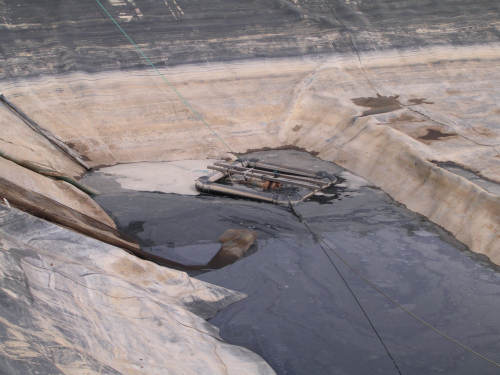
One of the most challenging applications for pumpmanufacturers is the processing of leachates in industrial waste treatment centres. In Europe, the by-products of industrial production processes – which include metals, chemicals, contaminated sludges and even nuclear waste – form giant industrial waste mountains that have to be carefully treated before they are safe enough to be sent to landfill.
However, these toxic waste mountains are not the only polluted substance that need to be dealt with at specialist treatment centres. Rain water percolates through the industrial waste mountains while they are stored and awaiting treatment, generating a toxic run-off liquid, or leachate, that is just as polluted and dangerous as the original waste pile. Usually, these liquids are channelled into vast holes dug into the earth to form controlled basins. The 1999 European Directive relating to the dumping of waste sets out strict criteria for the storage and processing of industrial leachates to ensure that the way they are collected, handled and eventually dumped complies with regulatory requirements.
For this reason, leachate basins are lined with membranes to stop the polluted water from penetrating the ground and entering the water table. This solution creates large chemical baths that offer a highly inhospitable environment for the pumpsthat are used to process the liquid. The pumpsselected have to be suspended 30 cm above the membrane so as to avoid suction on the membrane, which could cause a tear or a hole. They must also be robust enough to need little or no maintenance – since regularly accessing pumpsfor repairs in such a hazardous environment is understandably unpopular with treatment centre owners.
Problems of leachate handling
Alain du Petit Thouars, the CEO of Tsurumi's French dealer, offered to rent a Tsurumi pumpto the a French wastewater treatment company.
“We placed one of our KTZ3.7 kW pumpsin a very difficult site where the owner's experience was that all other pumpshad failed after only one week,” explains du Petit Thouars.
“After six months the KTZ33.7 was still running so well that when I asked the owner what he thought of it, he had forgotten it was even there.”
The wastewater company was so impressed with the performance of that first Tsurumi pumpand decided to purchase more. It has now been a customer of Tsurumi for over seven years and only uses Tsurumi pumpsfor the whole water treatment facility.
“The casing of the KTZrange of pumpsis made from cast iron rather than aluminium and the impellers are chromium cast iron, both of which are far more resistant to corrosion,” said Daniel Weippert, MD of Tsurumi (Europe) GmbH.
“This makes them an ideal choice for the particular stresses of leachate handling.”
The experience in France suggests that the KTZ pumpsare particularly well suited to alkaline leachate environments and that maintenance on Tsurumi pumpsat French waste product treatment centres is typically very low. This is an important consideration when operating in a toxic environment, as minimal handling is clearly the ideal.





